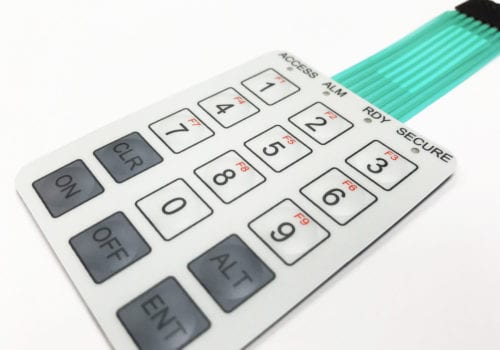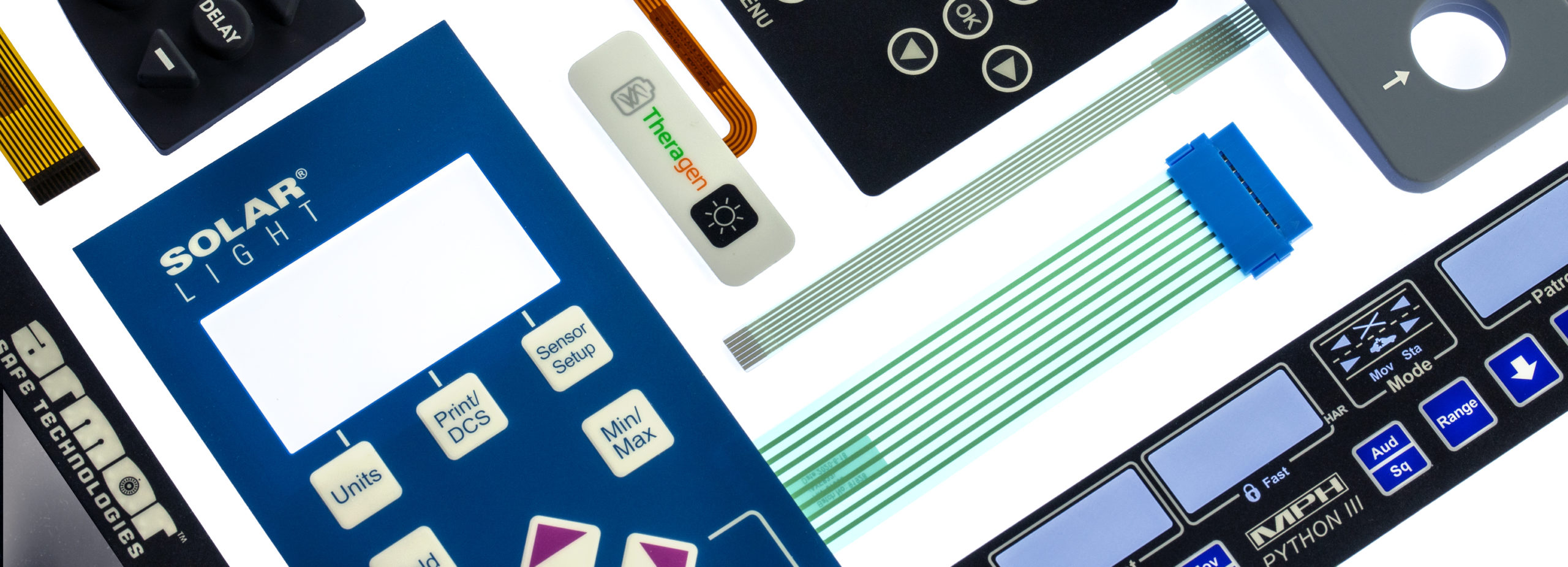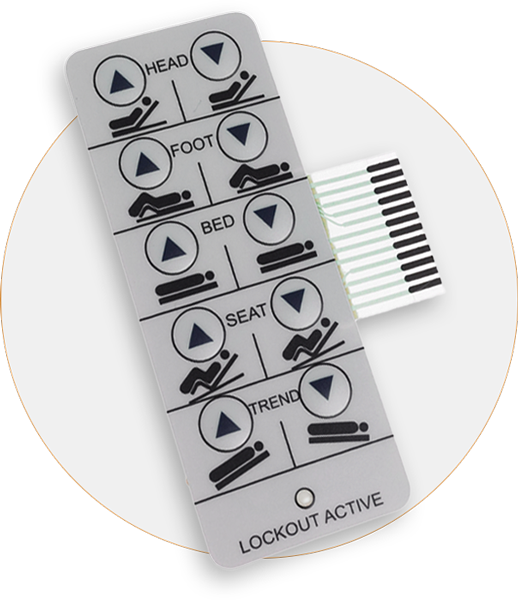An forward-thinking membrane switch manufacturer can offer modern features and materials.
An forward-thinking membrane switch manufacturer can offer modern features and materials.
Blog Article
Everything About Membrane Layer Change: Comprehending Its Style and Performance
When you consider the control interfaces in modern-day tools, membrane layer switches usually come to mind. These parts are greater than simply buttons; they mix design and performance flawlessly. Understanding exactly how they function and what makes them effective can alter your perspective on everyday electronics. There are nuances to their layout and performance that you might not be aware of. Let's explore what collections membrane layer switches aside from other control systems.
What Are Membrane Layer Switches?

Their seamless nature makes them easy to tidy and immune to dust and dampness, a vital function in several environments. Membrane switches can additionally be tailored concerning shape, size, and graphics, enabling manufacturers to create special user interfaces tailored to details items. And also, they're lightweight and thin, which helps in minimizing the overall mass of tools. Generally, membrane layer buttons play a substantial function in improving user experience across a broad selection of applications.
Just How Membrane Switches Job
When you push a key on a membrane layer switch, it turns on a simple yet effective device. The top layer, frequently constructed from versatile product, lowers onto a conductive layer below it. This action bridges the space between conductive traces, completing an electric circuit. As quickly as the circuit closes, it sends a signal to the gadget's controller, which interprets your input.
You'll observe that the tactile feedback varies based upon the switch design, offering either a soft click or a much more obvious reaction. When you launch the key, the membrane go back to its initial position, resuming the circuit and stopping the signal. This process occurs virtually instantaneously, making certain a receptive user experience.
Membrane switches are popular because of their sturdiness and resistance to dust and wetness, making them excellent for various applications, from family appliances to clinical tools. Comprehending this procedure assists you value their extensive use.
Secret Components of Membrane Switches
Comprehending the vital components of membrane switches is fundamental for comprehending their functionality and layout. At the core, you'll locate the visuals overlay, which provides the visual interface for users. Beneath that, there's a spacer layer that divides the circuit layers, making certain that they do not make call up until pressed. The circuit layer is where the magic happens; it includes conductive traces that finish the circuit when you push the switch. An additional essential element is the adhesive backing, enabling the switch to abide by surfaces securely. The safety layer guards against environmental factors and wear, expanding the button's life expectancy. Each element plays a significant role in making sure trusted efficiency and customer interaction. By understanding these elements, you'll gain insight right into just how membrane switches over operate and their relevance in numerous applications.
Materials Utilized in Membrane Switch Over Design
The efficiency and toughness of membrane layer switches heavily depend upon the products used in their design. You normally run into polyester and polycarbonate as main substrates due to their superb strength and versatility. These products resist scrapes and chemicals, making them perfect for requiring atmospheres.
The conductive layers frequently use silver or carbon, picked for their integrity and conductivity. membrane switch manufacturer. Silver gives premium efficiency, while carbon is a cost-efficient alternative. For the overlay, you may take into consideration a matte or shiny coating, relying on your aesthetic needs and user experience
Adhesives play a necessary duty as well; they bond layers firmly and assure durability. Make sure to pick adhesives that endure environmental factors like temperature level and moisture. Do not neglect the relevance of a great printing strategy for graphics, as it boosts both performance and visual allure. Picking the appropriate products will ensure your membrane layer button stands the test of time.
Layout Factors To Consider for Membrane Layer Buttons
While making membrane the original source buttons, it's important to take into account numerous elements that affect their performance and customer experience. Start by focusing on the layout and switch dimension; make particular they're user-friendly and simple to browse.
Don't forget the graphic style; clear labeling and shade comparison are significant for presence. Verify your design suits ecological factors, like wetness or temperature level variants, which click here for info might influence performance. Ultimately, remember the significance of testing models with genuine individuals to collect responses and make needed changes. This iterative process helps you fine-tune the style, validating it satisfies both practical and aesthetic requirements successfully. By meticulously considering these elements, you'll create a membrane switch that enhances usability and fulfillment.
Applications of Membrane Buttons
Membrane buttons are flexible parts located in different applications, from commercial equipment to consumer electronic devices. You'll see their influence in makers that call for sturdy interfaces and in devices that gain from sleek layouts. Recognizing these applications helps you value the functionality and usefulness of membrane switches in daily innovation.
Industrial Equipment Usage
When you're seeking to enhance the capability of industrial tools, membrane switches use a reputable service that incorporates longevity with user-friendly layout. These switches are perfect for rough settings, providing resistance to dirt, wetness, and chemicals. You'll locate them in control panels for making equipments, heating and cooling systems, and medical devices, where precision and responsiveness are vital. Their low profile means they fit effortlessly right into different equipment, saving valuable space while keeping convenience of usage. With adjustable why not try this out graphics and backlighting options, you can produce an intuitive user interface for operators, enhancing performance and security. And also, their lengthy life expectancy lowers maintenance prices, making them a wise financial investment for your commercial applications. Welcome membrane switches to improve your operations and boost total efficiency.
Customer Electronic Devices Assimilation
In the domain name of consumer electronics, membrane buttons play a crucial role in enhancing user interaction and tool capability. You'll discover them in devices like microwaves, remotes, and gaming consoles, giving a seamless way to communicate with technology. Their sleek style enables easy assimilation right into different products, making controls user-friendly and easy to use. With their ability to incorporate graphics and backlighting, you can enjoy a modern visual that enhances the tool's overall appearance. Membrane layer switches also assure longevity and resistance to dirt and wetness, prolonging the lifespan of your electronic devices. By choosing membrane buttons, you enhance not just the capability yet likewise the style of your devices, making day-to-day interactions smooth and enjoyable.
Advantages and Drawbacks of Membrane Layer Switches
While membrane layer switches supply an array of advantages, they additionally come with some drawbacks that you should consider. One substantial benefit is their compact layout, making them excellent for space-constrained applications.

Nonetheless, there are negative aspects. Membrane layer buttons can have a much shorter life-span compared to mechanical buttons, especially under heavy use. They can also be much less responsive, which could impact individual comments during procedure. Moreover, if harmed, repairing them can be tough and usually needs total substitute. Inevitably, their level of sensitivity to severe temperature levels and ecological problems might limit their performance in particular settings. Stabilizing these advantages and disadvantages will assist you establish if membrane layer buttons are the appropriate fit for your job.
Regularly Asked Inquiries
The Length Of Time Do Membrane Layer Changes Typically Last?
Membrane changes generally last in between 5 to ten years, depending upon use and environmental problems. You'll want to examine variables like wear, exposure to moisture, and temperature level changes to determine their longevity effectively.
Can Membrane Layer Switches Over Be Personalized for Particular Styles?
Yes, you can customize membrane buttons to fit details layouts (membrane switch manufacturer). You'll have the flexibility to select shades, shapes, and designs that match your job's demands, guaranteeing they mix effortlessly with your general aesthetic
What Is the Price Array for Membrane Layer Change Production?
The expense range for membrane button production generally falls between $1 and $10 per system, relying on factors like style intricacy, quantity, and materials. You can obtain quotes from producers to discover the ideal alternative.

Are Membrane Changes Waterproof or Resistant?
Membrane layer buttons can be made to be waterproof or resistant, depending upon materials made use of and building approaches. If you require them for damp atmospheres, guarantee you specify those demands throughout the design process.
Exactly How Do Membrane Layer Switches Over Contrast to Typical Buttons?
Membrane switches are generally thinner and much more versatile than conventional switches, using a smooth layout. They're usually much easier to cleanse and integrate, however could not offer the tactile comments you're used to with mechanical options.
Conclusion

Report this page